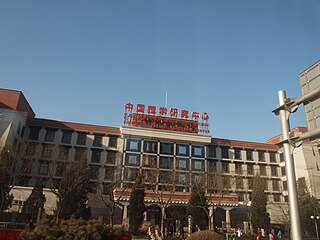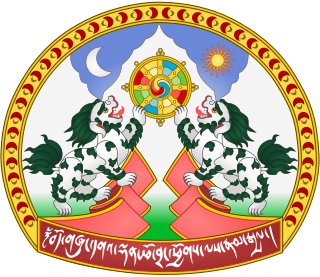
Dalai Lama is a title given by the Tibetan people for the foremost spiritual leader of the Gelug or "Yellow Hat" school of Tibetan Buddhism, the newest of the classical schools of Tibetan Buddhism. The 14th and current Dalai Lama is Tenzin Gyatso, who lives as a refugee in India.

The Panchen Lama, is a tulku of the Gelug school of Tibetan Buddhism. Panchen Lama is one of the most important figures in the Gelug tradition, with its spiritual authority second only to Dalai Lama. "Panchen" is an abbreviation of "Pandita" and "Chenpo", meaning "Great scholar".
The Tibetan independence movement is a movement for the independence of Tibet and the political separation of Tibet from China. It is principally led by the Tibetan diaspora in countries like India and the United States, and by celebrities and Tibetan Buddhists in the United States, India and Europe. The movement is no longer supported by the 14th Dalai Lama, who although having advocated it from 1961 to the late 1970s, proposed a sort of high-level autonomy in a speech in Strasbourg in 1988, and has since then restricted his position to either autonomy for the Tibetan people in the Tibet Autonomous Region within China, or extending the area of the autonomy to include parts of neighboring Chinese provinces inhabited by Tibetans.

Thubten Gyatso was the 13th Dalai Lama of Tibet.

Lobsang Trinley Lhündrub Chökyi Gyaltsen, born Gönbo Cêdän, was the tenth Panchen Lama, officially the 10th Panchen Erdeni, of the Gelug School of Tibetan Buddhism. He was often referred to simply as Choekyi Gyaltsen, although this is also the name of several other notable figures in Tibetan history.
Kelzang Gyatso (1708–1757), also spelled Kalzang Gyatso, Kelsang Gyatso and Kezang Gyatso, was the 7th Dalai Lama of Tibet.

Norbulingka is a palace and surrounding park in Lhasa, Tibet, China, built from 1755. It served as the traditional summer residence of the successive Dalai Lamas from the 1780s up until the 14th Dalai Lama's exile in 1959. Part of the "Historic Ensemble of the Potala Palace", Norbulingka is recognized as a UNESCO World Heritage Site, and was added as an extension of this Historic Ensemble in 2001. It was built by the 7th Dalai Lama and served both as administrative centre and religious centre. It is a unique representation of Tibetan palace architecture.

The history of Tibet from 1950 to the present started with the Chinese invading Tibet in 1950. Before then, Tibet had declared independence from China in 1913. In 1951, the Tibetans signed a seventeen-point agreement reaffirming China's sovereignty over Tibet and providing an autonomous administration led by Dalai Lama. In 1959 the 14th Dalai Lama fled Tibet to northern India under cover where he established the Central Tibetan Administration. The Tibet Autonomous Region within China was officially established in 1965.

The 1959 Tibetan uprising or the 1959 Tibetan rebellion began on 10 March 1959, when a revolt erupted in Lhasa, the capital of the Tibet Autonomous Region, which had been under the effective control of the People's Republic of China since the Seventeen Point Agreement was reached in 1951. Armed conflict between Tibetan guerillas and the People's Liberation Army (PLA) had started in 1956 in the Kham and Amdo regions, which had been subjected to socialist reform. The guerrilla warfare later spread to other areas of Tibet and lasted through 1962.

The China Tibetology Research Center is an academic research organization in Beijing, China devoted to the study of Tibet (Tibetology). It studies all aspects of Tibet including subjects related to everyday life in Tibetan areas.

The Sikyong is the head of the Central Tibetan Administration, a Tibetan exile organisation also known as the Tibetan Government-in-Exile. The title was created in 2012. On April 26, 2017, internal circular from Kashag announced that Sikyong would be rendered in English as 'President' of the Central Tibetan Administration

The 14th Dalai Lama is the current Dalai Lama. Dalai Lamas are important monks of the Gelug school, the newest school of Tibetan Buddhism, which was formally headed by the Ganden Tripas. From the time of the 5th Dalai Lama to 1959, the central government of Tibet, the Ganden Phodrang, invested the position of Dalai Lama with temporal duties.

Lodi Gyaltsen Gyari Rinpoche, Kasur Lodi Gyari or "as he is universally known to the Tibetan-speaking world, Gyari Rinpoche" was a Tibetan politician, and journalist who served as the 14th Dalai Lama's special envoy to the United States. Exiled to India in 1959, he was also the executive chairman of the International Campaign for Tibet.
Human rights in Tibet are a contentious issue. According to a 1992 Amnesty International report, judicial standards in China, including in the Tibet Autonomous Region, were not up to "international standards". The report charged the Chinese Communist Party government with keeping political prisoners and prisoners of conscience, including the death penalty in its penal code, ill-treatment of detainees and inaction in the face of ill-treatment of detainees, including torture, the use of the death penalty, extrajudicial executions, forced abortions, and sterilisation. The status of religion, mainly as it relates to figures who are both religious and political, such as the 14th Dalai Lama, is a regular object of criticism.

Padma Choling is a politician. He was the eighth and Chairman of the Tibet Autonomous Region (TAR), China, but in January 2013, was replaced by his deputy Losang Jamcan. Later he served as the Tibet Autonomous Region People's Congress. As Chairman of TAR, Choling was the "most senior ethnic Tibetan in the regional government", though he was subordinate to the TAR Communist Party Chief Zhang Qingli, and later his successor Chen Quanguo.

Protests and uprisings in Tibet against the government of the People's Republic of China have occurred since 1950, and include the 1959 uprising, the 2008 uprising, and the subsequent self-immolation protests.
The Lhasa riot of 1750 took place in the Tibetan capital Lhasa, and lasted several days during the period of Qing rule of Tibet. The uprising began on November 11, 1750 after the expected new regent of Tibet, Gyurme Namgyal, was assassinated by two Manchu ambans.

The Ganden Phodrang or Ganden Podrang was the Tibetan government that was established by the 5th Dalai Lama with the help of the Güshi Khan of the Khoshut in 1642. Lhasa became the capital of Tibet in the beginning of this period, with all temporal power being conferred to the 5th Dalai Lama by Güshi Khan in Shigatse. After the expulsion of the Dzungars, Tibet was under administrative rule of the Qing dynasty between 1720 and 1912, but the Ganden Phodrang government lasted until the 1950s, when Tibet was incorporated into the People's Republic of China. Kashag became the governing council of the Ganden Phodrang regime during the early Qing rule.

Tibet under Qing rule refers to the Qing dynasty's rule over Tibet from 1720 to 1912. During the Qing rule of Tibet, the region was controlled by the Qing dynasty established by the Manchus in China. In the history of Tibet, Qing administrative rule was established after a Qing army defeated the Dzungars who occupied Tibet in 1720, and lasted until the fall of the Qing dynasty in 1912, although the region retained a degree of political autonomy under the Dalai Lamas. The Qing emperors appointed imperial residents known as the Ambans to Tibet, who commanded over 2,000 troops stationed in Lhasa and reported to the Lifan Yuan, a Qing government body that oversaw the empire's frontier regions.


















